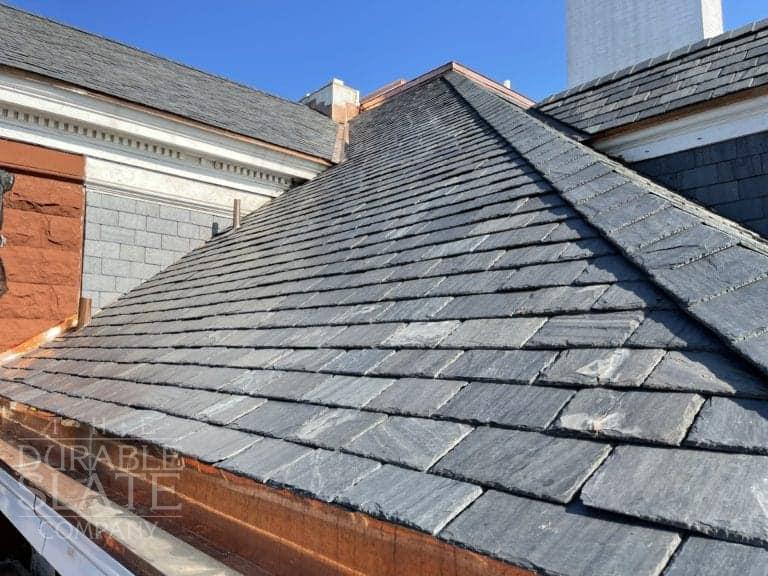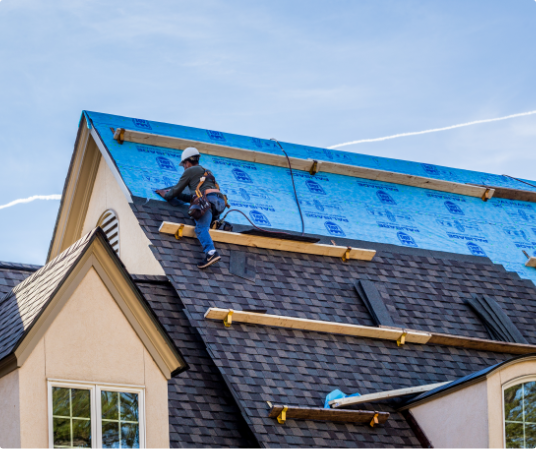Step-by-Step Overview to Locating the Right Roofing Companies in Gainesville
Wiki Article
Best Practices for Ensuring Appropriate Roof Covering Air Flow
Making certain correct roof covering ventilation is critical for the durability and performance of a roof. A well balanced intake and exhaust vent proportion, frequently 1:300, plays a crucial function, with intake vents preferably positioned at the lower edge of the roof covering for amazing air entry and exhaust vents at the height for cozy air leave. Normal evaluations to recognize obstructions and maintain clear air flow are paramount. In addition, keeping insulation away from vents is essential to avoid airflow limitation. Understanding these foundational aspects establishes the phase for more in-depth insights right into installation and upkeep practices that can dramatically boost your roof's performance.Understand Air Flow Basics
Properly comprehending ventilation basics is essential for ensuring the long life and efficiency of roof. Effective ventilation minimizes dampness accumulation and temperature extremes in the attic room, both of which can result in considerable structural damages over time. A well-ventilated roofing system aids in protecting against usual issues such as mold and mildew development, timber rot, and ice dams, which can compromise the honesty of the roof covering products and the underlying frameworks.The main goal of ventilation is to help with the motion of air, permitting a regular exchange between the outdoor and indoor atmospheres. This equilibrium is attained via a combination of consumption and exhaust vents that work together to keep optimum air movement. Consumption vents, usually located along the soffits or eaves, permit fresh air to get in the attic room room, while exhaust vents, often situated at or near the roof ridge, allow warm, moist air to run away.
Secret elements influencing the performance of roofing system air flow consist of appropriate positioning, appropriate sizing, and making certain that both intake and exhaust vents are unobstructed. Normal inspection and upkeep are vital to recognize potential clogs, damage, or inadequacies in the air flow system, consequently guarding the roof covering's efficiency and toughness.
Types of Roofing System Vents
Roof covering vents play an essential function in preserving effective attic room air flow and, by extension, the overall health and wellness of the roof. Different sorts of roof covering vents are available, each with special benefits customized to details roof covering requirements. Ridge vents, as an example, are set up along the roof's height, allowing warm, damp air to escape from the attic. They use constant air flow and mix effortlessly with the roofline, making them both effective and cosmetically pleasing.
Soffit vents are set up under the eaves and work in tandem with roof covering vents to guarantee a well balanced intake and exhaust system. By permitting cooler air to enter from below, soffit vents help with the expulsion of warm air with upper vents. Gable vents, situated on the exterior wall surfaces of the attic, offer one more reliable service, especially in homes with saddleback roofs.
Examine Your Existing Air Flow

Next, think about the age and condition of your roof covering products and air flow components. Older systems might not comply with current building ordinance or might have deteriorated gradually, decreasing their effectiveness. Conduct a thorough examination to identify any type of signs of damage, such as rust, damages, or gaps that might compromise the system's efficiency.
Additionally, gauge the attic room temperature and humidity levels. High temperatures and moisture can indicate inadequate ventilation.
Installment Best Practices
Reliable setup of roof covering ventilation systems is vital for guaranteeing optimal performance and longevity. Appropriate setup starts with recognizing the certain air flow demands of the building and the roofing it covers. This involves calculating the appropriate ratio of consumption to wear down vents, generally adhering to the 1:300 regulation, which states one square foot of air flow for every single 300 square feet of attic room flooring room.
The positioning of vents official statement is similarly crucial. Consumption vents must be installed at the roof covering's lower side, frequently in the soffits, to allow cool air to go into. Exhaust vents, their explanation on the other hand, need to be mounted near or at the roofing's height to assist in the exit of warm, damp air. This produces a natural air flow that aids preserve temperature and dampness equilibrium within the attic area.
Seal all vent connections thoroughly to stop air leaks and prospective water seepage. Usage high-grade products and follow producer guidelines to make sure durability and efficiency. Furthermore, integrating ridge vents with baffles can considerably boost air movement efficiency by stopping wind-driven rain and snow from entering the attic.
Inevitably, precise setup of roof ventilation systems minimizes prospective problems such as mold growth, ice dams, and architectural damages, ensuring the roofing system's integrity and the building's overall health.
Routine Maintenance Tips
Consistency in maintenance practices is basic to making sure the long-lasting effectiveness of roof ventilation systems. Throughout these examinations, guarantee that vents are complimentary of particles, nests, and other obstructions that can hamper air movement.
Cleaning the vents is another important job. Utilize a soft brush or a vacuum cleaner to eliminate dust and particles from intake and exhaust vents. Be careful not to damage the vent screens or louvers throughout the process. Furthermore, evaluate the attic room for any indications of water damages, which could jeopardize the honesty of the roof.
Correct insulation have a peek at these guys is just as vital. Guarantee that attic room insulation does not obstruct the vents, as this can significantly restrict air movement. If any insulation has moved or worked out, rearrange or change it to keep an effective obstacle.
Lastly, change any type of damaged or missing elements immediately. Busted vents, cracked roof shingles, or worn-out blinking can all add to insufficient air flow and needs to be addressed without delay. Regular maintenance guarantees that the roof air flow system functions optimally, thus expanding the life expectancy of the roofing itself.
Conclusion
Ensuring correct roofing air flow is critical for maintaining the performance and sturdiness of a roof covering system. Adherence to the 1:300 intake and exhaust vent ratio, combined with the strategic positioning of vents, is essential.A well balanced intake and exhaust air vent proportion, generally 1:300, plays a pivotal role, with consumption vents preferably placed at the lower edge of the roofing for awesome air entry and exhaust vents at the height for cozy air leave. Consumption vents, generally located along the eaves or soffits, allow fresh air to get in the attic space, while exhaust vents, commonly located at or near the roof covering ridge, enable hot, damp air to run away.
Soffit vents are installed under the eaves and work in tandem with roofing vents to make certain a balanced intake and exhaust system. By enabling cooler air to go into from below, soffit vents assist in the expulsion of hot air with top vents. Adherence to the 1:300 consumption and exhaust vent ratio, coupled with the critical placement of vents, is crucial.
Report this wiki page